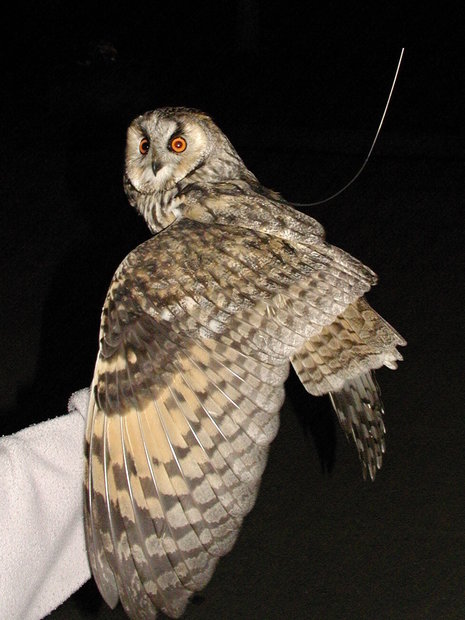Secrets of long-eared owls in urban environments

Of the eight commoner species of typical owls in Iran, five are residents, one is a common summer visitor (European scops owl or Otus scops) and two are mainly or wholly winter visitors (long-eared owl and short-eared owl).
Long-eared owls (Asio otus) breeds in forests in vicinity of open country, in copses among arable fields, in plantations on moors, in large parks with conifers, tall hedgerows and etc. Long-eared owls’ food are mainly voles, but also small birds, hunting both from perch and in flight, latter probably by far is the commonest method.
Diet composition of long-eared owls in an urban environment was unknown but many studies have been carried out till now. Scientists know the diet of raptors may change when they inhibit urban areas.
Dr. Matěj Lövy and his colleagues from Department of Zoology, University of South Bohemia studied the dietary composition of urban populations of long-eared owls during the 2000s. These studies indicated that the most frequently secondary prey is mice, and in years with poor vole’s availability, mice comprises a considerable part of the owl’s diet.
The Tehran Times had an interview with Lövy as a lead author, he described some of the most significant findings and provided recent updates on what we know and don’t know about these fascinating animals.
Q: How much the presence of urban long eared owl is important for controlling the population of urban pests such as Rattus novegicus and Rattus rattus?
A: I think the presence of urban long-eared owls is really important in terms of reducing the numbers of pests such as Rattus spp. Basically, foraging long-eared owls depend on presence of their main prey; in Europe, species of voles Microtus spp. (Especially M. arvalis) are the main prey of owls and their diet could rapidly change during the years where voles are scarce. During the prey shortage, owls usually hunt alternative prey, such as other rodents. In Asia and the Middle East, the situation could be rather different and it is of crucial importance to know the detailed species composition of the long-eared owl’s diet during longer period (It means in several years).
Q: And what about their relation with Corvus corone? This crow is a big challenge in my country now.
A: The long-eared owls depend on the presence of corvids in urban areas since they commonly use their abandon nests for breeding. In my opinion, Corvus corone could be such an important species in your country. I am not sure about the situation concerning other corvids in Iran but in our city, long-eared owls use old magpie nests mostly, but we have noticed successful breeding attempts in Corvus frugilegus breeding colony as well.
Q: What are the most important characters that make this species different?
A: Unlike other raptors, the long-eared owl is probably not able to nest on and/or inside the buildings, houses etc. Such occasions are really scarce (I remember only one scientific paper related to this issue). This fact disadvantages it against other synantrophic raptors such as kestrels, falcons, and barn owls.

Q: Your researches showed that this owl avoided vegetation types associated with human activities. But how could encourage Asio otus to be present in urban parks? Which plant species are eligible?
A: What I meant was that they avoid areas such as small fenced gardens etc. but not in general. It is very important to realize that two different “green urban areas” are important for owls for nesting and for hunting. And there is much difference between those. Urban parks are ideal places where long-eared owls can find suitable nesting sites. We know that sometimes only a small group of trees (up to five, may be less) presents a very suitable place for nesting. In Europe, it seems that conifers are preferred tree species but it very much depends on the situation at your study locality. I do not know how the situation in Iran is. Refugia are very important for hunting and as such they have to offer suitable environmental conditions for rodents, the main prey. For example, abandoned areas within the cities commonly offer higher rodent densities, or grassy river banks.
(Noted: Refugia is an area in which a population of organisms can survive through a period of unfavorable conditions, especially glaciation).
Q: Are long-eared owls readily to occupy artificial nests?
A: Hard to say, I have never tried to install artificial nests in our study area because owls always have plenty of natural breeding sites (old corvid nests). However, in general, I think they could occupy artificial nests as well. Such artificial nest could be something like a wooden base with breeding material (wooden branches and smaller sticks). I guess that a very important factor is to choose the most suitable site where to install this nest ideally on a mid-high tree which does not grow solitarily but in a group of several ones. For instance, urban parks seem to me a very appropriate place.
Q: Ecological cycles wiped out in megacities such as Tehran. How could we change this situation and bring essential species such as owls back to cities?
A: The ongoing trend is that owls and raptors in general have begun to follow many songbirds towards the cities across the world. Synantrophization is relatively young phenomenon but of increasing importance since it embraces more and more species across biota. Megacities can serve as an ideal place for raptors, both diurnal and nocturnal (e.g. common kestrels, falcons, long-eared owls etc.) since they offer more (and non-fluctuating) numbers of prey, less predators and also more pleasant weather conditions, “buffered temperature” (smaller range of extremes). So I am not sure if it is necessary (or even possible) to change this situation. In my opinion, raptors tend to take advantage of these conditions and this is reason why their numbers (in European cities) are still increasing.
Q: How urban barriers such as skyscrapers could affect long-eared owl ranges?
A: I guess drastically. Long-eared owls hunt rodents using harrier-like flight. This technique is the most effective at low flight which disadvantages moving across high buildings. On the other hand, owls for sure use corridors within the urbanized areas which interconnect suitable foraging sites (I call them refugia) and avoid high buildings. Generally, owls can easily nest in the park surrounded by skyscrapers and move for further distances to find a prey.
Q: What are the first steps to estimate population trends in nocturnal owls?
A: We have tried many different techniques and simulating a territorial intrusion by broadcasting a male’s territorial call is the best way. You should do this at the beginning of the breeding season. You can divide your study area into several (ideally of the same size) parts and broadcast a male’s territorial call close to urban parks or any suitable “green urban areas”. Second, it is very good to look for owl pellets. Owls use the same site for a long period and you can easily get data about numbers of nesting pairs during the breeding season. If you combine these methods, you will get the desired data.
Q: What was your method to assess the spatial activity of Asio otus?
I used radio-tracking. Nowadays, there are a lot of possibilities which mostly depend on your budget. GPS radio-tracking is a very effective method which saves your time since data are gathered automatically. However, I have no experience with this method. I did all my radio-tracking with hand antenna and receiver and followed owls using bicycle. It was fun but took really a lot of time and I am not sure, if this could be possible in Tehran.
Q: Could you point out some of burgeon conservation strategies?
A: A good idea is to start with artificial nests. It could (1) bring very interesting results and (2) increase population density of long-eared owls in Tehran and Iran in general. Furthermore, it will be excellent to have any data about the prey to analyze density of small mammals in Tehran. Ideally, you can divide the city into several parts and try to capture rodents there. You will get information about the species composition of small mammals’ community within the city. It is very important to do a pilot study in which you assess the population density of owls in Tehran. Based on these findings, you can more easily specify which parts of the city are of greater importance for long-eared owls and offer future possibilities for its population grow; I mean those parts which offer more green urban areas, such as parks. It is crucial to protect such areas because you protect owl’s habitat. This will be probably very challenging since this inherently involves discussion with local authorities...and as you know this is a long haul.
I think it is very vital to start in-depth study that includes various ecological aspects of the biology of the long-eared owl in Iran.
Leave a Comment